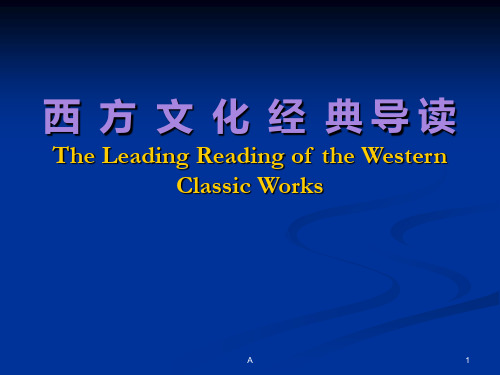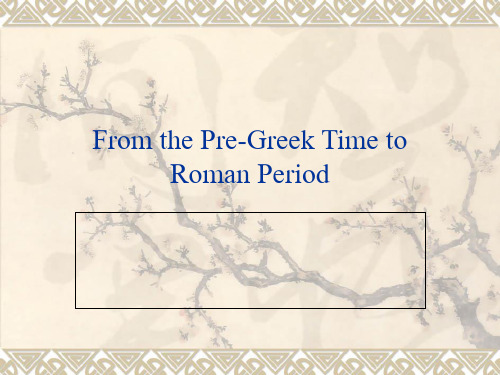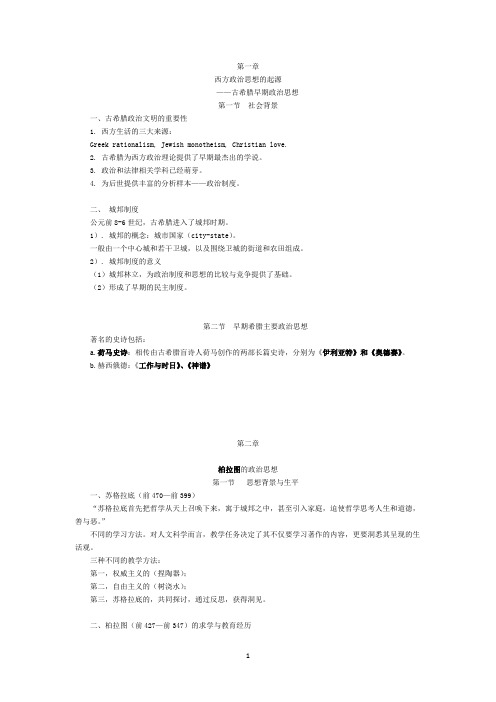西方思想经典导读第一讲
《西方思想经典》课件

萨特的存在主义与人道主义
总结词
自由选择与责任
社会与历史的挑战
萨特的存在主义与人道主义强调个体 的自由选择和责任,以及在社会和历 史背景下所面临的挑战和困境。
萨特认为个体的存在是自由的,每个 人都有权利选择自己的生活方式和价 值观。但同时,个体也必须为自己的 选择承担责任,并意识到自己的选择 对自身和他人的影响。
科学进步
西方思想经典推动了科学技 术的进步和发展,为人类的 生产力和生活水平的提高做 出了巨大贡献。
文化交流
西方思想经典是世界文化交 流的重要载体,促进了不同 文化之间的相互了解和融合 。
社会变革
西方思想经典对社会变革和 历史进步产生了深远影响, 为人类社会的进步和发展提 供了重要思想武器。
02
CATALOGUE
萨特认为个体在社会和历史背景下会 面临各种挑战和困境。他强调个体应 积极参与社会变革和发展,通过行动 来推动社会进步和实现人道主义理想 。同时,他也指出个体在面对困境时 需要勇敢地承担责任,不断探索和创 新,以实现个体的自由和价值。
THANKS
感谢观看
超人哲学
尼采提出超人概念,认为人类应通过培养超人的品质,超越自身的动物性和局限性,追求 更高的目标和意义。超人具有创造性和无限可能性,能够超越传统社会和文化的限制,实 现真正的自由和自我实现。
海德格尔的存在主义
01
总结词
海德格尔的存在主义强调个体存在的独特性和不可替代性,以及在面对
存在的意义和真理时所面临的困境和挑战。
的哲学思想对现代社会的发展产生了深远的影响。
04
CATALOGUE
近代哲学思想
笛卡尔的理性主义
总结词
笛卡尔是西方近代哲学的奠基人,他提出了“我思故我在”的著名论断,强调理性思考和怀疑一切的 精神。
西方思想经典导读第一讲

The Hebrews developed religious and ethical ideas that would be a foundation for both Christian and Islamic civilization.
❖ The civilization coalesced around 3150 BC with the political unification of Upper and Lower Egypt under the first pharaoh, and it developed over the next three millennia. Its history occurred in a series of stable
Similiarities between the Two Cultures:
❖ Both were dependent on rivers and the rich soil deposited be periodic floods;
❖ Both had to develop and maintain organized systems of irrigation and flood control;
❖ The word “Mesopotamia” is in origin a Greek name – “land between the rivers”, is a toponym for the area of the TigrisEuphrates river system, largely corresponding to modern-day Iraq, as well as some parts of northeastern Syria, southeastern Turkey, and southwestern Iran.
现代西方哲学第一讲讲稿

现代西方哲学第一讲讲稿《尼采》第一页哲学和哲学家以及哲学思想:各位亲爱的同学,大家好,今天我们一起学习到的内容是有关尼采的哲学思想,我想大家在这几周石老师的讲解中对于西方哲学的历史发展脉络以及哲学思想的演进都有了一个大致的了解了吧,不知道大家对于哲学、哲学家、哲学思想这些词语有一个怎样的认识与理解。
在开始我们今天的探究之前呢,我觉得我有必要跟大家分享一下有关这几个词的一般概念的一个一般理解,或者说是对石老师这几周以来的一个回顾吧。
西方哲学,从苏格拉底以来,或者从苏格拉底以前的人们那里,我们就可以看到西方人是如何思考和定义自然、探究自然的,然后一直到近代,人们从讨论自然现象到思考自然本质,从苏格拉底的两个世界到基督教的上帝,在到近现代的到我们自己,最有名的三个问题莫过于“我是谁”“我从哪里来”“我又将到何处去”,当然基督教大家更接受其是一种宗教,其实宗教又何尝不是一种哲学呢?前不久我看《历史转折中的邓小平》,我甚至觉得政治也是一种宗教,宗教也是一种哲学了。
西方有一个传统,从苏格拉底以来,人们对于这种思考万物本质的传统是由来已久,所以我们看到西方思想界是流派纷呈,众说纷纭啊,但是究竟谁说了算呢?似乎他们从来都渴望自成一家,让自己的思想成为别人的holy Bible,但是我们发现,真正的现实却是,他们实际上在很大的程度上只是说服了自己或者说说服了极短的一段时期的极少部分人,或者你会认为基督教是个例外,因为他至少在中世纪的漫长时间里席卷了整个欧洲,但是我们要看到在中世纪的年代里,因为宗教问题所发生的战争和争端就会发现,其实上帝的到来并非就给人们带来了福音,思想的交锋可谓从未停止过,直到马丁.路德的争论我们便清晰的看到了这种争论,之后的文艺复兴,人们的思想更是在这一时期爆炸了。
从培根、霍布斯到洛克、休谟,从笛卡尔到莱布尼兹,再到康德、黑格尔和叔本华,虽然他们的观点各异,思想纷繁复杂,但是,他们所关注的焦点是类似的甚至是相同的,那便是本质,一切存在的事物的本质。
西方思想经典导读部分课文翻译

西方思想经典导读部分课文翻译第一篇:西方思想经典导读部分课文翻译第一章伯里克利阵亡将士葬礼演说辞(修西得底斯)请允许我这样说,我们的政治体制并没有照搬邻国的制度。
与其说我们的制度模仿其他国家,不如说为其他国家提供了摹本。
我们的宪政被称作民主制,因为权力不是掌握在少数人手中,而是掌握在全体人民手中。
当解决私人间的争执时,法律面前人人平等;当一个人担任的公职比另一个人高时,并非考虑他是一个特权阶级的成员,而是他拥有的实际能力。
任何人,只要有能力为国家效力,都不会因其贫穷而在政治上处于卑微的地位。
而且,正如我们的政治生活是自由和开放的,我们的人与人相处的日常生活也是如此的。
如果邻邦欣赏自己的方式,我们不会因之而恼火,我们也不会对之怒目相视,尽管这不会带来真正的伤害,但依然会伤害人民的感情。
在我们的私人生活方面,我们是自由的和宽容的;但在公共事务上,我们遵循法律。
因为我们对法律尊重有加。
我们服从于我们赋之以权威的那些人们,我们也服从法律本身,尤其是那些保护被压迫者的法律,还有那些不成文的法律,违反这些法律被公认为是羞耻的。
还有一点,在我们工作之余,我们能够享受各种娱乐来放松我们的精神。
一年之中要定期举办各种各样的竞技和祭祀活动;在我们自己的家中,我们会找到美和美好的情趣,这使我们每天都感到愉悦,并驱散我们的烦恼。
那么,我们城市的伟大使得全世界的好东西都流入我们的国家,以至于对我们来说,似乎享受外国货物如同享受本地产品那些自然。
另外,我们和我们的对手在对待军事安全的态度方面有着很大的不同。
这里有些例证:我们的城市是向世界开放的,而且我们没有周期性地驱逐外邦人,以防止人们看到或发现我们赖以保持对敌人的军事优势的秘密。
这是因为我们所依赖的不是秘密武器(隐秘的法宝),而是我们自身真正的勇气和忠诚。
在我们的教育制度方面也有不同。
斯巴达人,从其最早的孩童时代,就受到最刻苦的勇气方面的培训;我们在没有这些约束的状态下过我们的生活,但却和他们一样准备着面对同样的危险。
西方思想经典导读

西方思想经典导读各位读友大家好,此文档由网络收集而来,欢迎您下载,谢谢西方经典思想3第一单元:shouldst eat to live ; not live to eat. 你应该为了活而吃;而不是为了吃而活2. The only good is knowledge and the only evil is ignorance.唯一的善,是知识;唯一的恶,是无知。
3. .The hour of departure has arrived, and we go our ways - I to die, and you to live. Which is better God only knows. 分手的时刻已经到来,我们将各走各的路─我将死了,你将活着。
那一种比较好呢?只有神知道。
4. True knowledge exists in knowing that you know nothing.真正的知识在于知道自己的无知。
5. If a man is proud of his wealth, he should not be praised until it is known howhe employs it.如果一个人以他的财富为骄傲,那么要看他如何运用财富,才知道他是否应该被称赞。
6. Wise men talk because they have something to say; fools, because they have to say something.智者说话,是因为他们有话要说;愚昧人,因为他们想说7. Living well and beautifully and justly are all one thing. --Plato好的生活和精美的公正都是一件事。
——柏拉图price good men pay for indifference to public affairs is to be ruled by evil men. –Plato. 好人对于公众事务冷漠的代价就是,被邪恶的人奴役。
西方法学经典著作

勇敢是一种保持,对“什么是应当害怕的”一种保持,在 任何条件下。在护卫者受的教育中,失去生命是不应该害 怕的,而抛弃护卫国家的原则和信念是不应该的。勇敢就 是在任何情况下保持教育确立起来的信念和原则。称职护 卫者的存在是国家勇敢的象征。
儿子:怎么分?我们都想多吃
母亲:要公平分
儿子:那怎么分?
母亲:切蛋糕的最后拿蛋糕,不切蛋糕的先拿蛋糕!!! 启示:程序的作用——追求正义结果,首先得程序正义
更深一步的思考?
程序正义的局限性 “人生的意义在于过程之中”吗?如果我想
给其中之一多分我就故意分不均匀 评论:没有程序是不可接受的,但仅有程序
【简要评述】
第二讲 主张法治优于一人之 治——亚里士多德《政治学》
一、关于国家的理论 (一)国家自然起源论
国家或城邦是从家庭经由村落共同体发展 而来的,由个人、家庭、村坊到城邦国家 的自然演化过程是人类的本性使然。
关于城邦的本性,亚里士多德认为:城邦 在本性上先于个人和家庭,但在发生的程 序上,个人和家庭则先于城邦。 因为,人 天生就是一个政治动物。
节制是从整个城邦来说的。城邦中还有生产者阶层,没有 受到教育,是欲望的象征。欲望是无限的,而节制是一种 秩序,就是对欲望的控制。在城邦中,节制就是统治者对 生产者的统治,有了节制,城邦才有秩序,达到和谐。
国家是智慧的、勇敢的,又是和谐有序的,只有 当国家中每个人各司其职,各做各的事情的时候, 城邦才能达到这种最佳状态,这时城邦也是正义 的。所以正义对城邦来说,就是城邦中每个人做 好自己的事情,不去做别人的工作。
西方文论导读

三、雅各布逊:
• • 雅各布逊:(1896—1982)形式主义与结构主义的奠基人。 1918年毕业于莫斯科大学,随后任莫斯科戏剧学院俄语教授; 1920年移居布拉格,1933年任教于捷克马萨里克大学,1939 年流亡北欧,1940年定居美国并加入美国籍,执教于著名的 哥伦比亚大学。1949年任哈佛大学斯拉夫语文学及普通语言 学教授。其学术经历分为俄国形式主义时期、捷克结构主义 时期及美国结构主义时期。 布拉格学派之父:1926年与穆卡洛夫斯基等创立布拉格学 派,1928年在海牙举行的第一届国际语言学大会上,与日内 瓦学派合作制订了一个结构和功能语言学纲领。把音位学作 为一种模式来分析诗性语言。 1960年之后,又成为巴黎先锋派文学理论社团“太剀尔” 杂志的撰稿人。
• 3.研究方法: • 语言学的研究方法: • a.内部研究:文学的文学性。把文学与其它事物 加以区分,把文学研究与其它研究加以区分。 (历史学、哲学、社会学、心理学、政治学……) • 学院派文艺学研究现状:现实主义理论与象征 主义理论(哲学的、宗教的、心理学的、历史的 解释)。 • 科学性问题 • b.形式主义。对内容,对所指的完全否定。
• c.文学本质研究: • 文学的文学性问题。 • 文学与现实世界的关系。 • “艺术永远独立于生活,它的颜色从不反映飘扬在 城堡上空的旗帜的颜色。”(什克洛夫斯基) • “诗歌性表现在哪里?表现在词使人感觉到是词, 而不只是所指对象的表示者或者情绪的发作,表现在 词和词序、词义及其外部和内部形式,不只是无区别 的现实引指,表现在获得了自身的分量与意义。” (雅各布逊) • 艺术实际上是游戏性的,并不与固定的意义相联 系。词就是词,首先和主要的是它的音响的经验和物 质性和具体性。无意义词语是任何艺术结构力求达到 的理想境界。(艾亨鲍姆) • 形式与内容的关系
西方思想经典导读章节介绍翻译

Chapter 1 Greek Culture古希腊是用来描述在古代讲希腊语世界的术语。
它不仅指目前希腊国家的领土,还包括那些希腊人定居的地区: 塞浦路斯、土耳其爱琴海海岸(当时称为lonia),西西里和意大利南部(被称为大希腊),希腊定居点分散在海岸上,即现在的阿尔巴尼亚,保加利亚、埃及、利比亚、罗马尼亚、西班牙、法国和乌克兰。
传统意义上,古希腊时期被认为以西元前776年第一次奥运会为开端,但大多数历史学家现在把开端扩展到西元前1000年左右。
传统的古希腊时期以西元前323年亚历山大大帝的去世为结束。
接下来的时期被称为希腊化,一直持续到西元前146年——希腊半岛和岛屿被罗马兼并。
希腊的民族,在分割的地理环境和各种各样族群的影响下,发展为城邦——小定居点成长为小王国。
这些城市分别独立发展。
然而,存在一种普遍的发展模式,即情况在每个特定阶段多多少少会有所不同。
君主制屈从于贵族制,贵族制接着被僭政取代。
在希腊大陆的僭政很快屈从于寡头政体或民主政体,并通过有限的公民权和奴隶主予以缓和;在希腊的政治民主的理念便应运而生。
梭伦在雅典创立民主制。
军事化的斯巴达有独特的宪制和社会发展。
交战的城邦有一种团结的意识;他们所有的公民认为他们自己都是古希腊人。
特别是雅典戏剧性地成长。
戏剧,诗歌,雕塑,建筑学和哲学繁荣起来,并且这里有蓬勃的智识生活。
一些西方文化中大名鼎鼎的和在雅典思想史上享誉盛名的人在这一时期诞生:剧作家埃斯库罗斯,阿里斯多芬尼斯,欧里庇得斯和索福克里斯,哲学家亚里士多德,柏拉图和苏格拉底,历史学家希罗多德,修西得底斯和色诺芬,诗人西蒙尼戴斯和雕刻家菲迪亚斯。
这座城市成为如伯里克里所说“希腊人的学校”。
古希腊被大多数历史学家视作西方文明的奠基文化。
希腊文化对罗马帝国有强大的影响,他把这种版本带到欧洲的许多地方。
古希腊文明已经极大地影响了现代世界的语言、政治、教育体制、哲学、艺术和建筑学,尤其是在西欧文艺复兴期间,并在18、19世纪各种新古典主义的复兴时期再次影响了欧洲和美洲。
西方思想经典导读部分课文翻译

第一章伯里克利阵亡将士葬礼演说辞(修西得底斯)请允许我这样说,我们的政治体制并没有照搬邻国的制度。
与其说我们的制度模仿其他国家,不如说为其他国家提供了摹本。
我们的宪政被称作民主制,因为权力不是掌握在少数人手中,而是掌握在全体人民手中。
当解决私人间的争执时,法律面前人人平等;当一个人担任的公职比另一个人高时,并非考虑他是一个特权阶级的成员,而是他拥有的实际能力。
任何人,只要有能力为国家效力,都不会因其贫穷而在政治上处于卑微的地位。
而且,正如我们的政治生活是自由和开放的,我们的人与人相处的日常生活也是如此的。
如果邻邦欣赏自己的方式,我们不会因之而恼火,我们也不会对之怒目相视,尽管这不会带来真正的伤害,但依然会伤害人民的感情。
在我们的私人生活方面,我们是自由的和宽容的;但在公共事务上,我们遵循法律。
因为我们对法律尊重有加。
我们服从于我们赋之以权威的那些人们,我们也服从法律本身,尤其是那些保护被压迫者的法律,还有那些不成文的法律,违反这些法律被公认为是羞耻的。
还有一点,在我们工作之余,我们能够享受各种娱乐来放松我们的精神。
一年之中要定期举办各种各样的竞技和祭祀活动;在我们自己的家中,我们会找到美和美好的情趣,这使我们每天都感到愉悦,并驱散我们的烦恼。
那么,我们城市的伟大使得全世界的好东西都流入我们的国家,以至于对我们来说,似乎享受外国货物如同享受本地产品那些自然。
另外,我们和我们的对手在对待军事安全的态度方面有着很大的不同。
这里有些例证:我们的城市是向世界开放的,而且我们没有周期性地驱逐外邦人,以防止人们看到或发现我们赖以保持对敌人的军事优势的秘密。
这是因为我们所依赖的不是秘密武器(隐秘的法宝),而是我们自身真正的勇气和忠诚。
在我们的教育制度方面也有不同。
斯巴达人,从其最早的孩童时代,就受到最刻苦的勇气方面的培训;我们在没有这些约束的状态下过我们的生活,但却和他们一样准备着面对同样的危险。
有这方面的证据:当斯巴达人入侵我们的国土时,他们不是自己来,而是让他们的所有同盟者一道来;而当我们在海外发动一次进攻时,我们是靠自己的,而且尽管在外邦领土上作战,还能常常打败那些为自己的家灶和家园而战的人们。
西方政治思想史讲义

第一章西方政治思想的起源——古希腊早期政治思想第一节 社会背景一、古希腊政治文明的重要性1. 西方生活的三大来源:Greek rationalism, Jewish monotheism, Christian love.2. 古希腊为西方政治理论提供了早期最杰出的学说。
3. 政治和法律相关学科已经萌芽。
4. 为后世提供丰富的分析样本——政治制度。
二、 城邦制度公元前8-6世纪,古希腊进入了城邦时期。
1). 城邦的概念:城市国家(city-state)。
一般由一个中心城和若干卫城,以及围绕卫城的街道和农田组成。
2). 城邦制度的意义(1)城邦林立,为政治制度和思想的比较与竞争提供了基础。
(2)形成了早期的民主制度。
第二节 早期希腊主要政治思想著名的史诗包括:a.荷马史诗:相传由古希腊盲诗人荷马创作的两部长篇史诗,分别为《伊利亚特》和《奥德赛》。
b.赫西俄德:《工作与时日》、《神谱》第二章柏拉图的政治思想第一节 思想背景与生平一、苏格拉底(前470—前399)“苏格拉底首先把哲学从天上召唤下来,寓于城邦之中,甚至引入家庭,迫使哲学思考人生和道德,善与恶。
”不同的学习方法。
对人文科学而言,教学任务决定了其不仅要学习著作的内容,更要洞悉其呈现的生活观。
三种不同的教学方法:第一,权威主义的(捏陶器);第二,自由主义的(树浇水);第三,苏格拉底的,共同探讨,通过反思,获得洞见。
二、柏拉图(前427—前347)的求学与教育经历学术志趣的转变——由文学而哲学创立阿卡德米学园,培养了大量既懂自然科学,又懂政治学和哲学的治国之才。
三、主要著作《理想国》、《政治家》、《法律篇》。
第二节 正义与城邦一、正义问题的重要性城邦败坏的根源在于个人行为失范,失范的原因在于不知道何为正义。
二、对各种正义观的批判1. 正义就是偿还债务2. 正义就是强者的利益?3. 不正义能带来更大的利益?柏拉图认为,正义是心灵的德行,不正义是心灵的邪恶。
西方政治思想史第一章

第三节
亚里士多德的政治思想
一、生平与著作
●时代背景 ●出身外邦 ●以师为靶 ●游历生活 ●创立学园 ●《政治学》
(公元前384-332)
理性的研究方法
(一)首次进行学科划分
伦理学→家政学→政治学
(二)创立政治学 (三)运用各种先进的方法
历史和经验→自然科学→实证→发生学
(四)独特的分析途径
基本元素→宏观整体
实现全体公民的最大幸福,就是统治者的幸福。 铸造一个整体的幸福国家。 只要护卫者成为护卫者就能使国家有良好的秩序。
贤人政体→军阀政体→财阀政体 →民主政体 →僭主政体 崇尚知识→荣誉 → 财富→ 自由 → 专制
柏拉图如何批判民主制?
极端之专制必产生于极端之自由
五、晚年政治思想
(一)《Stateman》
法律是多数人制定的,体现多数人的智慧 法律是正义的化身。 法律恰恰是免除一切情欲影响的神祗 法治不易于腐败
法治的两层内涵
●已成立法律获得普遍服从 ●人们所服从的法律是良法
(四)人口和疆域应当适量 (五)培育优良公民
善德方能造成善邦 邦国如忽视教育,其政治必将毁损 教育的主要目的是培育公德,提高公民 的政治素质 义务教育制 教育要制定立法,统一实施
灵魂三要素:理性→激情→欲望 希腊四主德:智慧→勇敢→节制→正义
3、等级划分的依据
质地说
正义就是三个等级的人各司其职,各得其所,皆忠其 事,以造成极和谐的有机体。这就是正义的城邦。
理想国——一个正义的城邦
一个让人觉得幸福的城邦 和谐、统一、强盛
四、哲学王思想(哲学家治国论)
(一)反思城邦现实:理想国家的建立唯有依赖 伟大的哲学家 政治专制腐败 社会分裂混乱 统治者无知无能 公民品性堕落 (二)哲学王的特点
西方文化经典导读

幸福为善行的极致和善德的完全实现。欲达 到这样的目的,一个城邦和其中的公民们须有 适 当的健康身体、财富以及一般生活配备,这些配 备都受之于自然。在具有这些自然条件的城邦中, 立法家运用其才能,引导公民纳入于行善的良轨。 人们所由成德达善者,出于三端,禀赋、习惯、 理性。
第一卷叙述苏格拉底和他的朋友关于 “正义”问题的一场讨论,实际是全书的 一个引子。
第二卷从“个人的正义”转入“城邦的 正义”,引出了城邦的定义,并提出建立 一个城邦需要什么人。
第三卷讨论了城邦中谁当统治者、人们 如何划分等级以及实行共产同住的问题。
A
13
“我们必须把真实看得高于一切”,但 “国家的统治者,为了国家的利益,可以 用它来应付敌人,甚至应付公民”
A
27
现存亚里士多德著作主要有:《范
畴》、《解释》、《前分析》、《后分 析》、《论辩》、《智者的驳辩》,总称 《工具论》,主要涉及逻辑问题;《形而 上学》,主要涉及抽象的一般理论问题; 《物理学》、《论天》、《论生灭》、 《论灵魂》,主要涉及自然哲学问题; 《尼各马可伦理学》、《大伦理学》、 《欧德谟伦理学》,主要涉及伦理问题。 此外还有《政治学》、《诗学》、《修辞 学》及其他有关生物、经济等方面的著
A
7
一、柏拉图其人
柏拉图(Plato,公元前427-347年)是古 希腊著名思想家,出生于雅典一个大贵族奴 隶主家庭,原名亚里斯托克尼。他一生的大 部分时间在古希腊民族文化的中心雅典。作 为一个贵族子弟,柏拉图从小受到良好教育, 他7岁开始上学,他12岁接受体育训练,18岁 时柏拉图服过一次兵役。20岁,拜当时著名 学者苏格拉底为师,专门学习哲学,不久就 成为苏格拉底最得意的门生。
西方思想经典导读第一讲 ppt课件

❖ The word “Mesopotamia” is in origin a Greek name – “land between the rivers”, is a toponym for the area of the Tigris-Euphrates river system, largely corresponding to modern-day Iraq, as well as some parts of northeastern Syria, southeastern Turkey, and southwestern Iran.
❖ Time: 5 to 6 thousand years agoБайду номын сангаасand shortly after that at the end of the 4th millennium B.C.
❖ Geography: Mesopotamia near the Tigris and Euphrates River and Egypt around the Nile
❖ Ancient Egypt was an ancient civilization of eastern North Africa, concentrated along the lower reaches of the Nile River in what is now the modern country of Egypt.
❖ In 226 AD, it fell to the Sassanid Persians, and remained under Persian rule until the 7th century Arab Islamic conquest of the Sassanid Empire. A number of primarily Christian native Mesopotamian states existed between the 1st century BC and 3rd century AD.
西方政治思想史讲义

第一章西方政治思想的起源——古希腊早期政治思想第一节社会背景一、古希腊政治文明的重要性1. 西方生活的三大来源:Greek rationalism, Jewish monotheism, Christian love.2. 古希腊为西方政治理论提供了早期最杰出的学说。
3. 政治和法律相关学科已经萌芽。
4. 为后世提供丰富的分析样本——政治制度。
二、城邦制度公元前8-6世纪,古希腊进入了城邦时期。
1). 城邦的概念:城市国家(city-state)。
一般由一个中心城和若干卫城,以及围绕卫城的街道和农田组成。
2). 城邦制度的意义(1)城邦林立,为政治制度和思想的比较与竞争提供了基础。
(2)形成了早期的民主制度。
第二节早期希腊主要政治思想著名的史诗包括:a.荷马史诗:相传由古希腊盲诗人荷马创作的两部长篇史诗,分别为《伊利亚特》和《奥德赛》。
b.赫西俄德:《工作与时日》、《神谱》第二章柏拉图的政治思想第一节思想背景与生平一、苏格拉底(前470—前399)“苏格拉底首先把哲学从天上召唤下来,寓于城邦之中,甚至引入家庭,迫使哲学思考人生和道德,善与恶。
”不同的学习方法。
对人文科学而言,教学任务决定了其不仅要学习著作的内容,更要洞悉其呈现的生活观。
三种不同的教学方法:第一,权威主义的(捏陶器);第二,自由主义的(树浇水);第三,苏格拉底的,共同探讨,通过反思,获得洞见。
二、柏拉图(前427—前347)的求学与教育经历学术志趣的转变——由文学而哲学创立阿卡德米学园,培养了大量既懂自然科学,又懂政治学和哲学的治国之才。
三、主要著作《理想国》、《政治家》、《法律篇》。
第二节正义与城邦一、正义问题的重要性城邦败坏的根源在于个人行为失范,失范的原因在于不知道何为正义。
二、对各种正义观的批判1. 正义就是偿还债务2. 正义就是强者的利益?3. 不正义能带来更大的利益?柏拉图认为,正义是心灵的德行,不正义是心灵的邪恶。
人心善则为人也是善的,人心恶那做人也是恶的。
- 1、下载文档前请自行甄别文档内容的完整性,平台不提供额外的编辑、内容补充、找答案等附加服务。
- 2、"仅部分预览"的文档,不可在线预览部分如存在完整性等问题,可反馈申请退款(可完整预览的文档不适用该条件!)。
- 3、如文档侵犯您的权益,请联系客服反馈,我们会尽快为您处理(人工客服工作时间:9:00-18:30)。
It
fell to Alexander the Great in 332 BC and after his death it became part of the Greek Seleucid Empire. Around 150 BC, Mesopotamia was under the control of the Parthians. Mesopotamia became a battleground between the Romans and Parthians, with parts of Mesopotamia (particularly Assyria) coming under periodic Roman control. In 226 AD, it fell to the Sassanid Persians, and remained under Persian rule until the 7th century Arab Islamic conquest of the Sassanid Empire. A number of primarily Christian native Mesopotamian states existed between the 1st century BC and 3rd century AD.
Classical
Period (500-336 BC) - Classical period of ancient Greek history, is fixed between about 500 B. C., when the Greeks began to come into conflict with the kingdom of Persia to the east, and the death of the Macedonian king and conqueror Alexander the Great in 323 B.C. In this period Athens reached its greatest political and cultural heights: the full development of the democratic system of government under the Athenian statesman Pericles; the building of the Parthenon(希腊的帕台农神庙) on the Acropolis; the creation of the tragedies of Sophocles(索福柯勒斯), Aeschylus(埃斯库罗 斯) and Euripides(欧里庇得斯); and the founding of the philosophical schools of Socrates and Plato.
The civilization coalesced around 3150 BC with the political unification of Upper and Lower Egypt under the first pharaoh, and it developed over the next three millennia. Its history occurred in a series of stable Kingdoms, separated by periods of relative instability known as Intermediate Periods. Ancient Egypt reached its pinnacle during the New Kingdom of slow decline. Egypt was conquered by a succession of foreign powers in this late period, and the rule of the pharaohs officially ended in 31 BC when the early Roman Empire conquered Egypt and made it a province.
Time:
5 to 6 thousand years ago and shortly after that at the end of the 4th millennium B.C. Geography: Mesopotamia near the Tigris and Euphrates River and Egypt around the Nile Siganificance: Although westerners are more ready to recognize their roots in Greek Civilization, actually western civilization was born in the ancient Near East.
The
word “Mesopotamia” is in origin a Greek name – “land between the rivers”, is a toponym for the area of the Tigris-Euphrates river system, largely corresponding to modernday Iraq, as well as some parts of northeastern Syria, southeastern Turkey, and southwestern Iran.
Brief History:
The
history of Greece can be traced back to Stone Age hunters. Later came early farmers and the civilizations of the Minoan and Mycenaean kings. This was followed by a period of wars and invasions, known as the Dark Ages. In about 1100 BC, a people called the Dorians invaded from the north and spread down the west coast. In the period from 500-336 BC Greece was divided into small city states, each of which consisted of a city and its surrounding countryside.
Difference between the Two Cultures:
Mesopotamia
was not as well protected geographically as Egypt and was thus more open to attack; The rivers Trigris and Euphrates were not as navigable, nor were the floods as regular as the Nile’s; So the culture of Mesopotamis reflected a sense of instability and pessimism in comparison to the stability and optimism that characterized Egyptians.
From the Pre-Greek Time to Roman Period
The General Structure:
Pre-Greek
Period Greek Culture Roman Culture
Two Main Parts: Mesopotamian and Egyptian Culture
Areas Covered by Ancient Greece
It
refers not only to the territory of the present Greek state, but also to those areas settled by Greeks: Cyprus, the Aegan coast of Turkey, Sicily and southern Italy, and the scattered Greek settlements on the coasts of what are now Albania, Bulgaria, Egypt, France, Libya, Romania, Spain, and Ukraine.
The Main Contents:
Geography
Brief
History Significance Key figures and representative works
Ancient
Greece is the term used to describe the Greek-speaking world in ancient times.
Other Cultures between the Two:
Between
these two areas there arose a number of smaller states, the most important of which were the Phoenician and the Hebrew states. The Phoenicians, a merchantile people, facilitated trade, established colinies, and spread Near Eastern culture. The Hebrews developed religious and ethical ideas that would be a foundation for both Christian and Islamic civilization.
